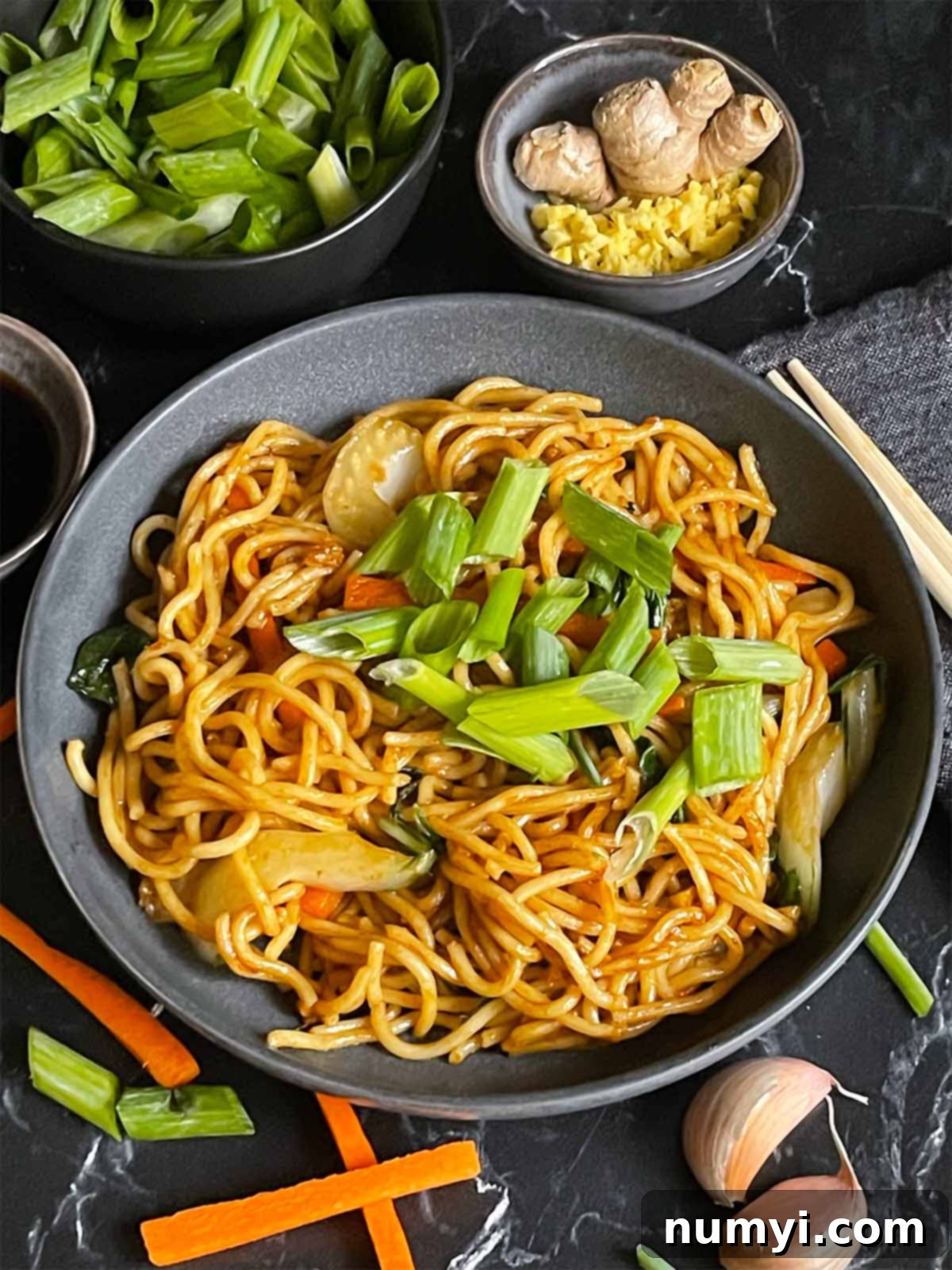Easy & Authentic Homemade Vegetable Lo Mein Recipe (Better Than Takeout!)
Are you craving a dish that’s bursting with fresh flavors, satisfying noodles, and crisp vegetables, all while being incredibly simple to make? Look no further! This easy homemade Vegetable Lo Mein recipe is exactly what you’ve been searching for. It’s so delicious, so vibrant, and so effortlessly prepared that it might just become your new favorite over any restaurant takeout. Prepare to dive into a world of incredible taste that proves simplicity can be truly spectacular!
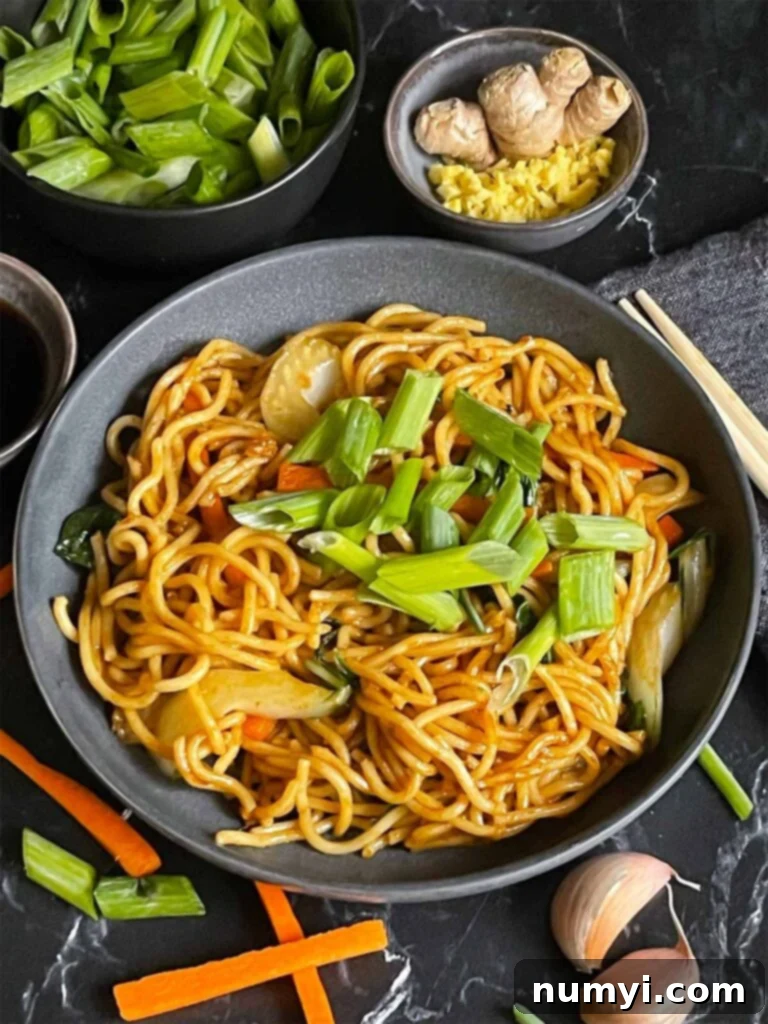
Why You Will Love This Easy Lo Mein Recipe
There are countless reasons why this Vegetable Lo Mein recipe will quickly become a cherished favorite in your kitchen. First and foremost, its incredible simplicity sets it apart. Forget complicated cooking techniques or hard-to-find ingredients; this recipe focuses on fresh, readily available items you can easily pick up from your local grocery store. No more searching for obscure sauces or specialty noodles! This approach ensures that anyone, regardless of their cooking experience, can whip up a truly impressive meal.
The secret to its outstanding flavor lies in those fresh ingredients. Unlike many takeout versions where vegetables might be overcooked or bland, here, you’re guaranteed crisp, vibrant veggies and bold, balanced flavors in every single bite. We’re talking about the delightful crunch of perfectly cooked bok choy and carrots, harmonizing with aromatic ginger and garlic. This isn’t just some noodles cooked down with vegetables; it’s a symphony of textures and tastes that make the dish truly shine. You’ll be amazed at the difference fresh produce makes, elevating a simple Lo Mein into a truly memorable culinary experience.
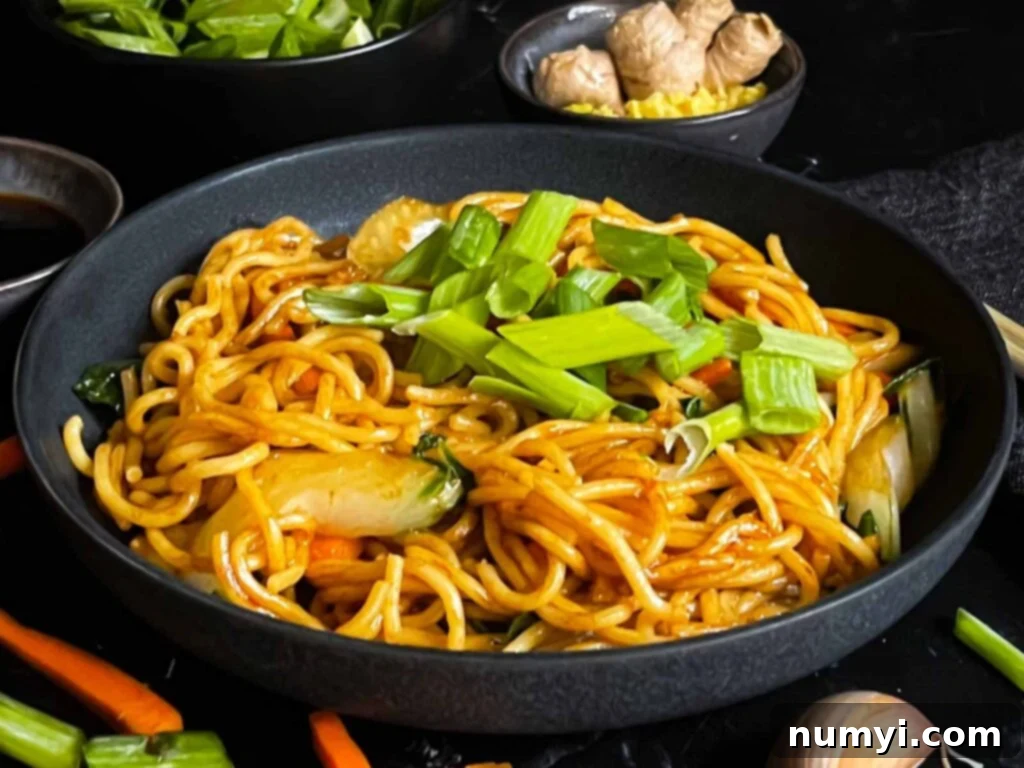
Beyond its fantastic taste and fresh appeal, the cooking process itself is a dream. Once your minimal chopping and ingredient preparation are done – what chefs call “mise en place” – this dish comes together in a flash. We’re talking about just minutes in the pan, making it an ideal choice for those hectic weeknights when you’re super hungry and don’t want to wait an eternity for dinner. The swift cooking ensures your vegetables retain their desirable crunch and nutrients, and the noodles are perfectly coated in the rich, savory sauce. Trust me, this homemade Lo Mein is a total game-changer for anyone looking for quick, healthy, and incredibly tasty meals that satisfy every craving.
Don’t Sweat The Recipe is supported by its readers. We may earn a commission if you purchase through a link on our site. Learn more.
Key Ingredients for Flavorful Vegetable Lo Mein
Alright, let’s break down the essential ingredients you’ll need to create this killer homemade Lo Mein. While everything is pretty straightforward, each component plays a vital role in building the incredible depth of flavor that makes this dish truly amazing. Gathering these fresh ingredients beforehand is crucial for a smooth and enjoyable cooking experience.

- Vegetable Stock (or Broth): This liquid gold forms the flavorful base of your sauce. It contributes a mild yet rich undertone, ensuring the sauce isn’t overly salty or one-dimensional. Using a good quality vegetable stock will make a noticeable difference in the overall depth of your Lo Mein.
- Dark Soy Sauce: This isn’t just for color, though it does provide that signature deep, appetizing hue to your noodles. Dark soy sauce delivers a profound, complex umami flavor that is essential for an authentic Lo Mein experience. While low-sodium soy sauce can be a substitute, be aware that the final color and flavor depth might vary slightly.
- Oyster Sauce: This is the absolute game-changer for your Lo Mein sauce! It brings a unique and irresistible combination of savory richness, subtle sweetness, and a hint of brininess. Its thick consistency also helps the sauce cling beautifully to the noodles and vegetables, truly elevating the entire dish.
- Cornstarch: A vital thickening agent, cornstarch ensures your sauce achieves that perfect glossy consistency, allowing it to coat every strand of noodle and every piece of vegetable flawlessly. It’s the key to preventing a watery Lo Mein and creating that desirable restaurant-quality texture.
- Sesame Oil: A little goes a long way with this aromatic oil. Added at the end, a dash of sesame oil infuses the entire dish with a distinctive nutty, toasted flavor, providing an instant and profound boost to the overall aroma and taste profile of your homemade Lo Mein.
- Vegetable Oil: Used for sautéing, vegetable oil is your go-to for getting those initial aromatic ingredients, like ginger and garlic, perfectly cooked and fragrant without overpowering the other flavors.
- Fresh Ginger & Garlic: These two are the dynamic duo that kickstart the flavor party! Freshly minced ginger offers a warm, zesty, and slightly pungent note, while garlic provides a robust, savory foundation. Together, they create an irresistible aroma that fills your kitchen and forms the core of this delicious Lo Mein.
- Bok Choy: Adding a beautiful splash of green and a delightful texture, bok choy brings a fresh, leafy crunch to the mix. It’s not just about the greens; it’s about that satisfying fresh bite that contrasts wonderfully with the soft noodles.
- Carrots: Thinly sliced carrots provide a vibrant pop of color and a natural hint of sweetness, along with a pleasant, tender-crisp texture. They contribute both visually and texturally to the overall appeal of the Lo Mein.
- Cooked Stir Fry Noodles: The undisputed star of the dish! These noodles are designed to soak up all the incredible flavors of the sauce, providing the comforting and substantial body of your Lo Mein.
- Green Onions (for garnish): A final flourish of sliced green onions adds a vibrant visual element and a sharp, fresh, allium kick that brightens the entire dish, cutting through the richness of the sauce.
Each of these carefully selected ingredients plays its unique part in creating a Vegetable Lo Mein that’s bursting with balanced flavor, appealing color, and satisfying texture. It’s like each one is a piece of a delicious puzzle that comes together to make something truly extraordinary and tasty.
A Note About Noodles: Choosing the Best for Your Lo Mein
When it comes to noodles for your Lo Mein, the good news is that you have a fair amount of flexibility. Don’t stress too much about finding an exact type; use what you can easily get your hands on. However, for the best results and a truly authentic experience, some options stand out more than others. Excellent choices include traditional Chinese egg noodles, dedicated fresh Lo Mein noodles, or specifically labeled stir-fry noodles. We’ve experimented with both fresh and dried noodles in our kitchen, and we strongly recommend opting for fresh noodles whenever possible. They tend to have a superior texture and absorb the sauce more effectively. Fresh noodles are usually available in the refrigerated section of most Asian markets and many larger local grocery stores, like these ones you can find online. If fresh noodles aren’t an option, dried egg noodles or even spaghetti or linguine in a pinch will work, just ensure you cook them al dente and prepare them correctly as outlined in the cooking steps.
How To Make the Best Vegetable Lo Mein at Home
Creating this irresistible Vegetable Lo Mein is a straightforward process, but like any culinary masterpiece, it benefits greatly from a little preparation. Before we dive into the exciting part of stir-frying, let’s get our “mise en place” (everything in its place) sorted. This strategic step ensures that once you start cooking, everything flows smoothly and quickly, which is crucial for stir-fries.
Step-by-Step Preparation: Setting Up for Success
First up, tackle the fresh vegetables. You’ll want to finely dice your ginger and garlic. This fine dice is key, as it allows them to cook evenly and quickly release their potent, aromatic flavors into the oil, forming the foundational fragrance of your dish. Next, move on to the bok choy, chopping it into convenient bite-sized pieces. This ensures even cooking and makes for perfect, easy-to-eat forkfuls that integrate well with the noodles. Don’t forget the carrots; slice them thinly into julienne sticks or coins for a pleasing crunch and visual appeal.
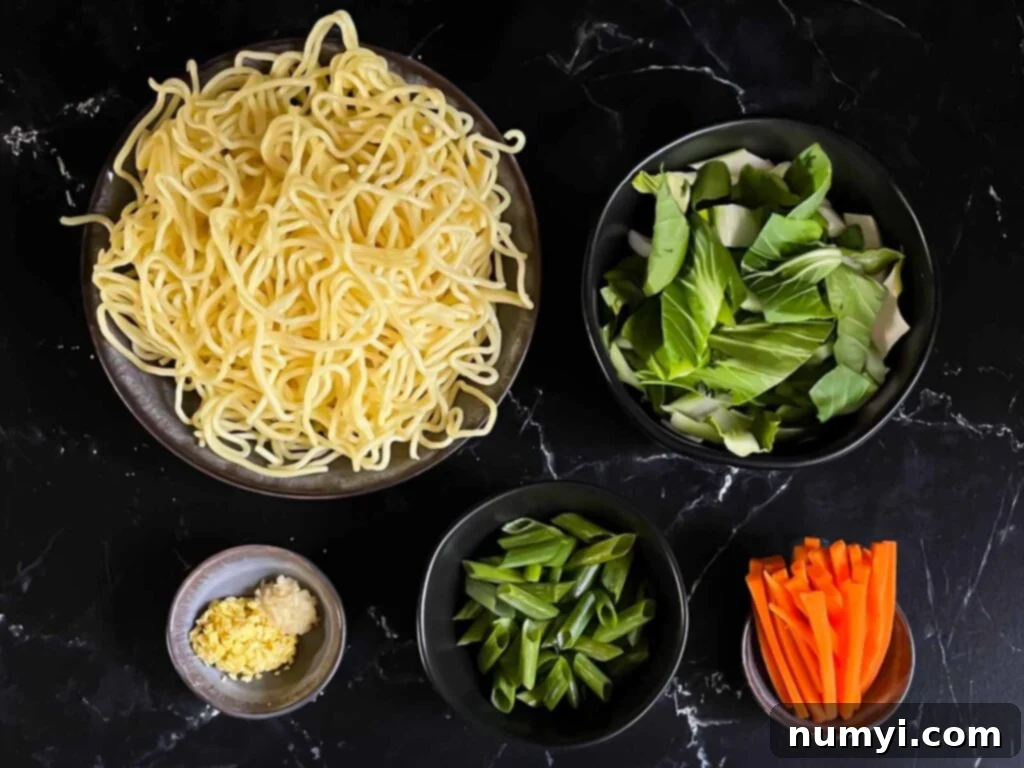
And for that extra touch of flair and a sharp, fresh taste, slice your green onions on a bias. Reserve most of these for a vibrant garnish at the very end.
Now, let’s talk about the star of the show: the sauce. This is where your Lo Mein starts to develop its signature character and depth. Begin by combining your vegetable stock with the cornstarch in a medium bowl. Whisk thoroughly until the cornstarch is completely dissolved and no lumps remain. This step is absolutely crucial for a silky-smooth sauce that thickens beautifully without any grainy texture. Once that’s perfectly mixed, incorporate the dark soy sauce, rich oyster sauce, and a touch of fragrant sesame oil. Give it another good stir to ensure all the components are well integrated. Set this flavorful concoction aside, ready for its moment in the pan.
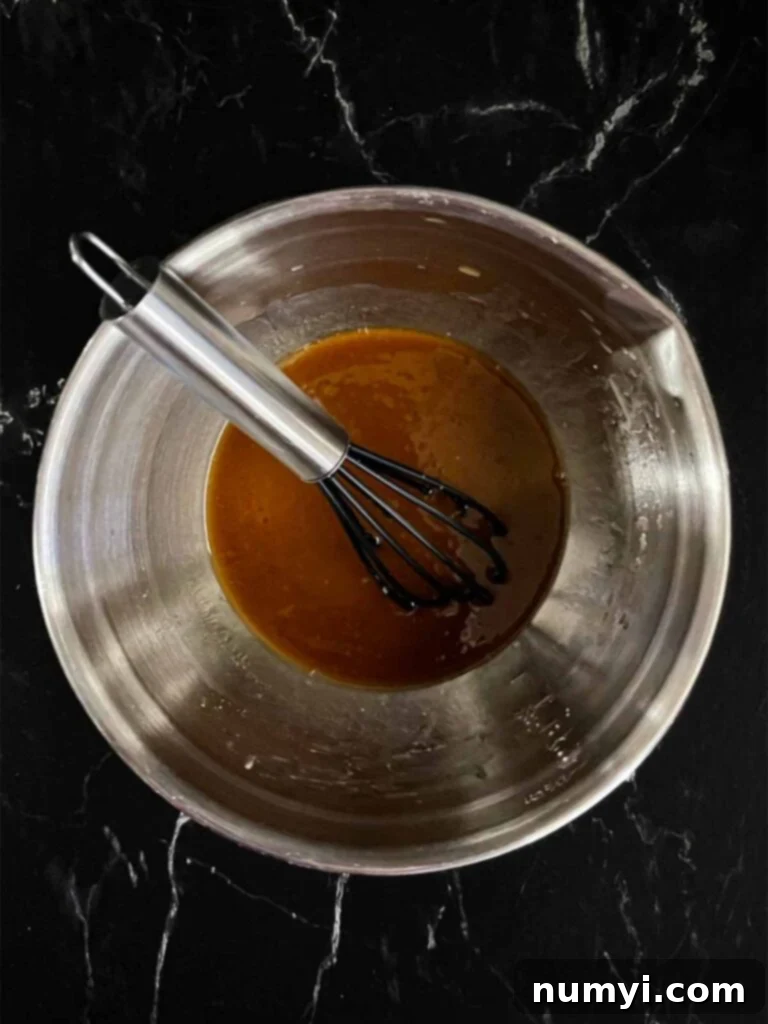
Finally, prepare your noodles. If you’re using dry noodles, cook them according to the package instructions until they are perfectly al dente – meaning they still have a slight bite. Immediately after cooking, rinse them thoroughly under cold water to halt the cooking process and prevent them from sticking together. A little trick here is to let them drain and even air dry for a few minutes to remove excess moisture. If you’re using fresh noodles (which we highly recommend for their superior texture), simply have them ready to go; they usually don’t require pre-cooking if they’re specifically designed for stir-frying or Lo Mein.
With all the chopping, mixing, and noodle prep meticulously done, you’re now perfectly set up for the actual cooking. Everything will come together quickly and smoothly, making the cooking process as enjoyable and stress-free as savoring the final, delicious dish!
- Begin by heating a generous splash of vegetable oil in a large pan or wok over medium-high heat. The key here is to get your pan nice and hot, which is essential for proper stir-frying. Once the oil glistens and is hot but not smoking, add your finely diced ginger and garlic. Stir them constantly for just about a minute or two until they become wonderfully fragrant and begin to turn a light golden color. This step creates the aromatic foundation for your entire Lo Mein, so don’t rush it!
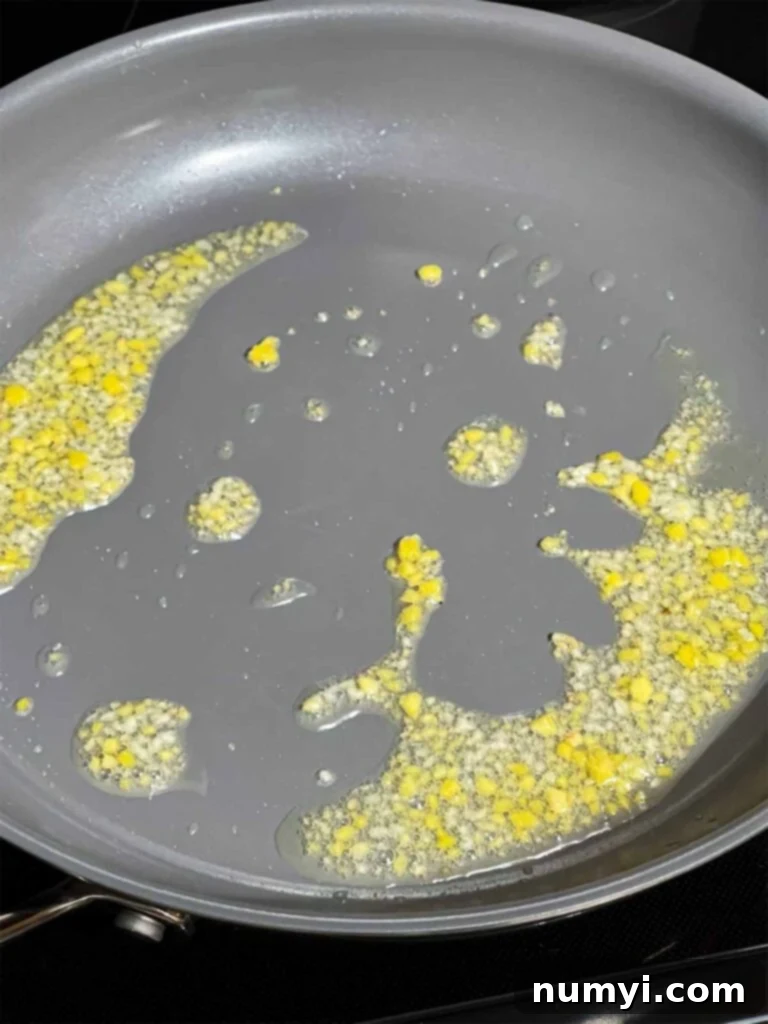
- Next, add your thinly sliced carrots and chopped bok choy to the pan. Keep the heat medium-high. Give the vegetables a good, vigorous stir, tossing them to ensure they cook evenly. Allow them to cook for just a few minutes, stirring frequently, until they soften slightly but still retain a vibrant color and a pleasant, satisfying crunch. The goal is tender-crisp, not mushy! As they cook, they’ll start to mingle beautifully with the ginger and garlic, creating a wonderful and aromatic base for your homemade Lo Mein.
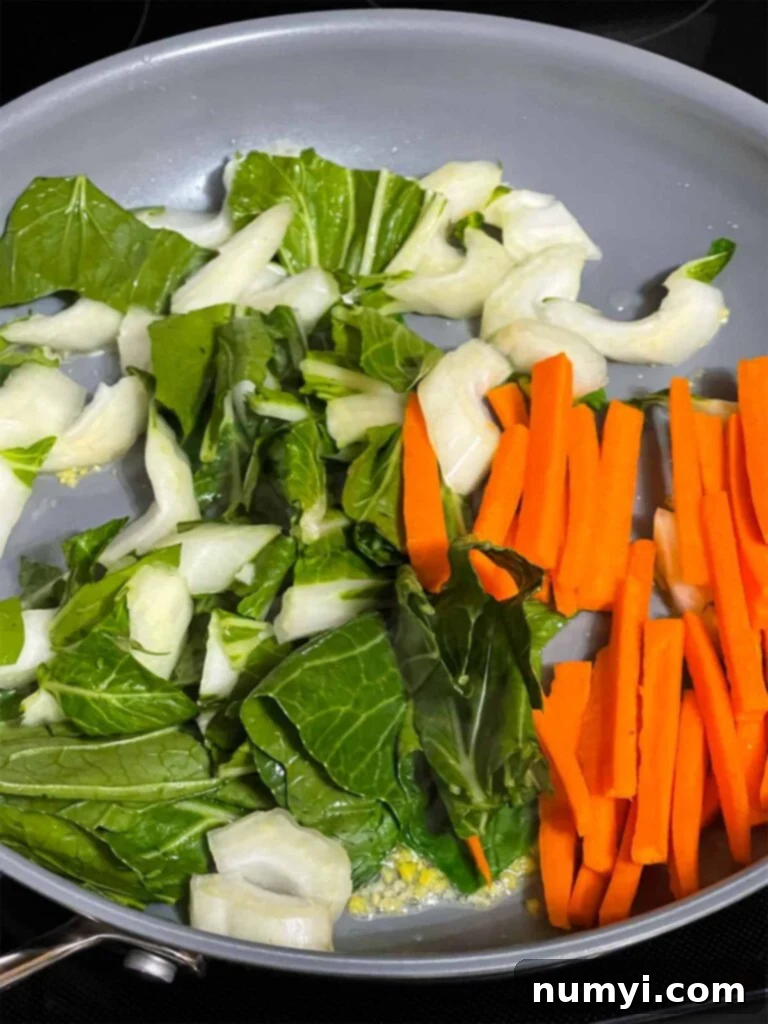
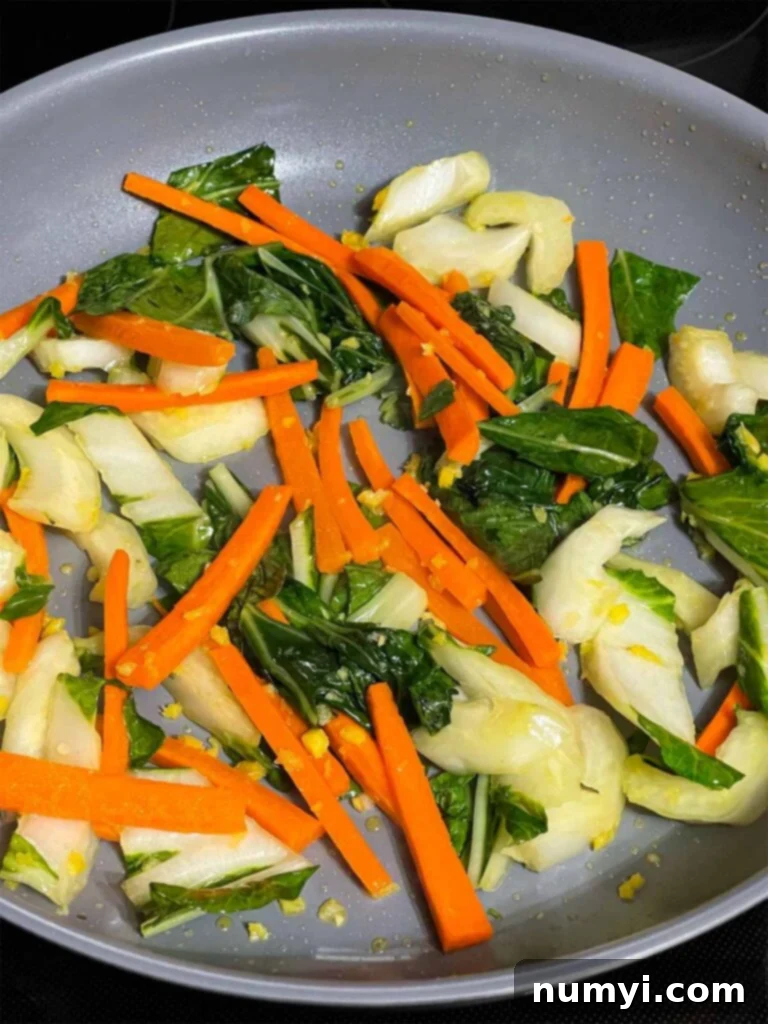
- Once your vegetables have reached that perfect tender-crisp stage, it’s time to introduce the cooked noodles to the pan. Add them in and give everything a good, quick toss using tongs or a spatula to ensure the noodles are thoroughly mixed with the sautéed veggies. Then, spread the mixture out a bit and let it sit undisturbed for about a minute or so. This crucial step allows the noodles to make direct contact with the hot pan, encouraging them to develop a slightly crispy, golden-brown char, adding another fantastic layer of texture to your Lo Mein.
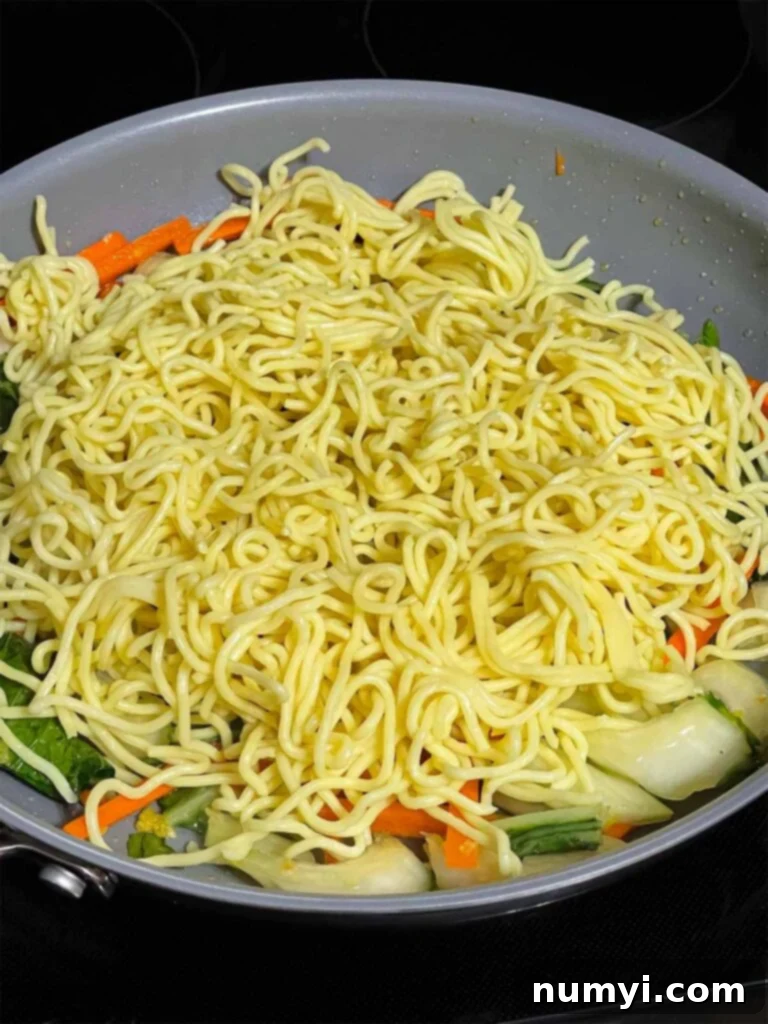
- Give the noodles and vegetables another quick toss or two, making sure everything is well combined and distributed in the pan. Now comes the moment of truth: pour your meticulously prepared sauce evenly over the noodles and veggies in the pan. The delicious aromas will intensify immediately!
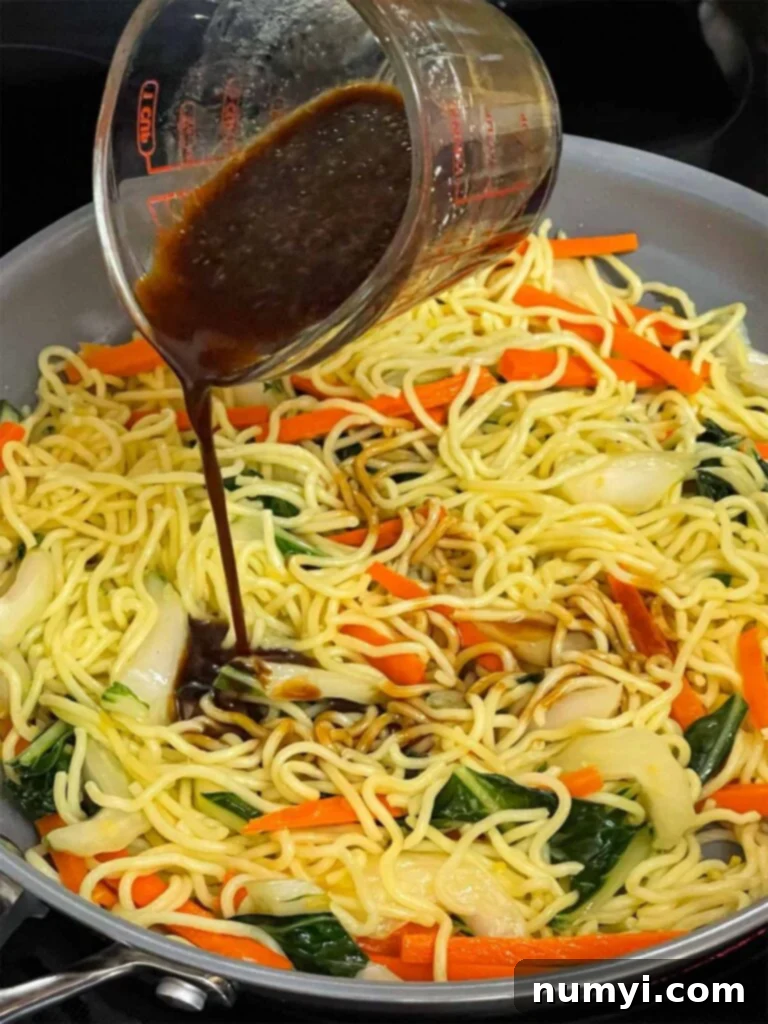
- Immediately and gently stir everything together, ensuring that the noodles and all the vibrant veggies are thoroughly and evenly coated with the rich, glossy sauce. Keep stirring and tossing for another minute or two. As the sauce heats up, the cornstarch will activate, causing it to thicken beautifully and cling perfectly to all the ingredients. This action will envelop every bite in its rich, savory, and slightly sweet flavors. This is the moment your homemade Lo Mein truly comes alive!
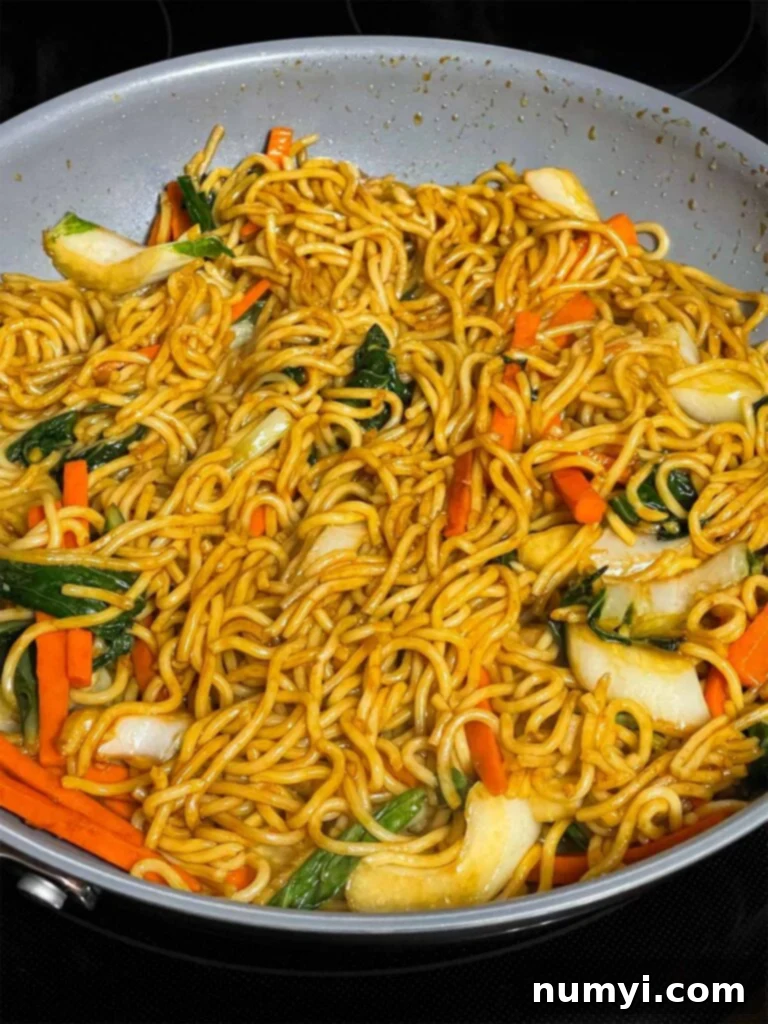
After a couple more minutes, when everything is heated through and the sauce has reached that perfect thickened, glossy consistency, turn off the heat. Your incredible, homemade Vegetable Lo Mein is now ready to be savored! Dish it onto individual plates or into a large serving bowl. For a final flourish and an extra burst of fresh flavor, generously sprinkle the reserved chopped green onions on top. And there you have it – a steaming, intensely flavorful, and visually appealing homemade Vegetable Lo Mein that doesn’t just rival, but confidently surpasses, any takeout option you might consider!
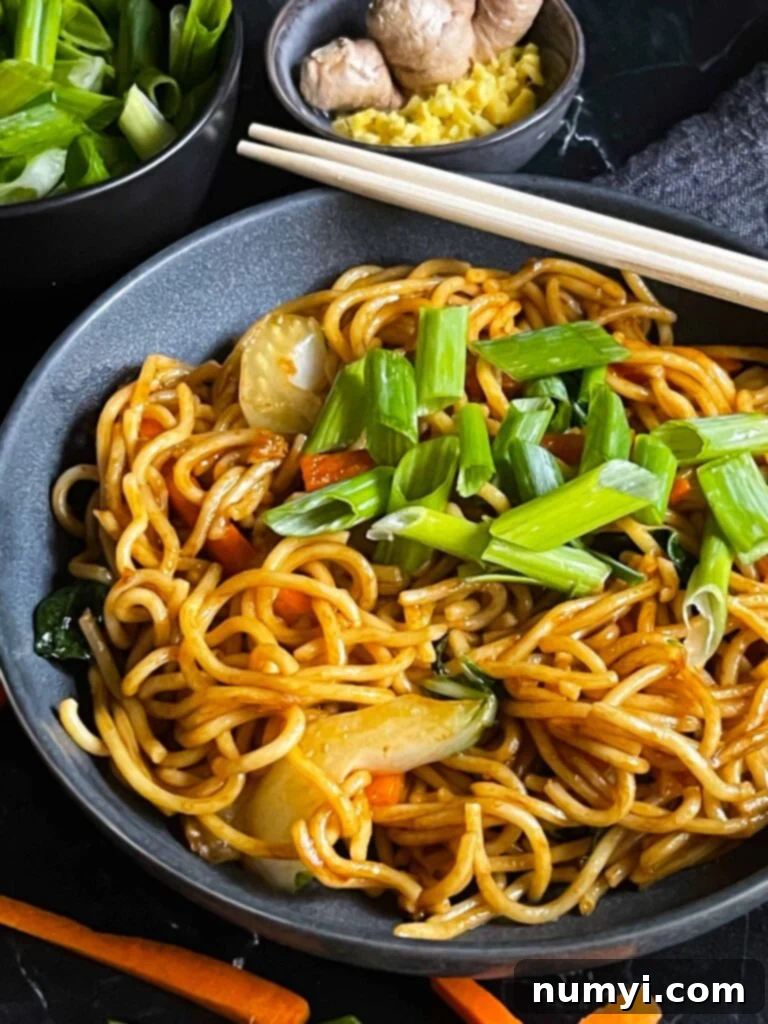
This dish is a vibrant testament to the fact that genuinely great food doesn’t have to be complicated or require extensive culinary training. With simple, fresh ingredients and a few straightforward, quick cooking steps, you’ve created a meal that’s not just satisfying and wholesome but also packed with dynamic fresh flavors and delightful textures that truly dance in your mouth. It’s a versatile and perfect dish for a swift weeknight dinner, a casual get-together with friends where you want to impress without stress, or any time you crave something a bit special and comforting without the fuss of ordering out. So go ahead, enjoy the delicious fruits of your minimal labor, and bask in the glory of your culinary creation. This Lo Mein isn’t just good; it’s a homemade masterpiece that’s sure to become a beloved staple in your recipe rotation!
Expert Tips for Perfect Homemade Lo Mein
Achieving restaurant-quality Lo Mein at home is easier than you think, especially with these insider tips:
Customize to Your Taste & Dietary Needs: The true beauty of a versatile dish like Lo Mein is its adaptability. Feel free to unleash your creativity and swap in your absolute favorite vegetables or add a protein that suits your preferences. Think tender strips of tofu, succulent chicken breast, juicy shrimp, or even thinly sliced beef. You can also fine-tune the sauce to your exact liking: a bit more soy sauce for enhanced saltiness, a sprinkle of sugar for added sweetness, or a splash of rice vinegar for a tangy kick. Don’t be afraid to experiment to discover the perfect flavor balance that suits your personal palate and makes this Lo Mein uniquely yours.
Embrace High Heat for Authentic Stir-Frying: When it comes to mastering the art of stir-frying, high heat is not just your friend, it’s your best ally. A very hot pan or wok ensures that your ingredients cook quickly and efficiently, searing their surfaces while retaining their delightful crunch and vibrant color. This rapid cooking also helps to lock in their natural flavors, preventing them from becoming soggy and infusing them with that characteristic “wok hei” (breath of the wok) flavor. Always make sure your cooking vessel is smoking hot before you add any ingredients. This crucial technique will give you that authentic stir-fry texture and mouthwatering taste that truly sets homemade Lo Mein apart.
Utilize Cold, Cooked Noodles for Optimal Texture: This might sound counterintuitive, but if you’re using dry noodles, cooking them ahead of time, rinsing them under cold water, and then allowing them to air dry slightly can make a significant difference. This process stops the cooking, prevents the noodles from clumping together, and ensures they don’t overcook or turn mushy when they hit the hot pan during the stir-fry. Cold noodles also maintain their integrity better and absorb the flavorful sauce more effectively without breaking down. This simple, yet often overlooked trick, is key to achieving that perfect, springy Lo Mein consistency that holds up beautifully to the sauce and vegetables.
Don’t Overcrowd the Pan: This is a golden rule for stir-frying. If you add too many ingredients to your pan at once, the temperature will drop dramatically, causing your ingredients to steam rather than stir-fry. This results in soggy vegetables and noodles instead of crisp, flavorful ones. If you have a large quantity of vegetables, cook them in batches to maintain high heat and achieve that desired tender-crisp texture. Once each batch is perfectly cooked, you can combine them all at the end before adding the sauce.
Freshly Grate Ginger and Garlic: While pre-minced garlic and ginger can be a time-saver, nothing compares to the vibrant, pungent flavor of freshly grated or minced aromatics. Take the extra minute to prepare them just before cooking; it will imbue your Lo Mein with an unparalleled depth of flavor and a fresher aroma that truly enhances the dish.
Delicious Lo Mein Variations to Explore
This Vegetable Lo Mein recipe is a fantastic starting point, but its true beauty lies in its versatility. Here are some exciting variations to keep things fresh and cater to different tastes:
Protein-Packed Lo Mein: For those seeking a more substantial and protein-rich meal, integrating your favorite protein is incredibly easy. Consider thinly sliced chicken breast, tender beef strips, plump shrimp, or flavorful pan-fried tofu. The method is simple: cook your chosen protein in the pan first until it’s just cooked through, then remove it and set it aside. Proceed with the vegetable stir-fry and noodle steps as usual. Finally, add the cooked protein back into the pan just when you pour in the sauce, allowing everything to heat through and meld together beautifully. This variation is perfect for creating a more filling and balanced meal that satisfies everyone.
Spicy Lo Mein Twist: If you’re a connoisseur of heat and enjoy a fiery kick in your dishes, transforming your Lo Mein into a spicy sensation is a must-try. Introduce a few dashes of your favorite sriracha sauce or a spoonful of robust chili garlic sauce directly into your regular sauce mix. For an extra layer of heat and fresh zing, consider tossing in some thinly sliced fresh chili peppers (like bird’s eye chilies or jalapeños) when you stir-fry the ginger and garlic, or with the other vegetables. This spicy version will undoubtedly ignite your taste buds and add an exciting element of warmth to your meal for those who crave a bit of excitement.
Gluten-Free and Veggie-Heavy Lo Mein: Catering to dietary needs or simply aiming for an even healthier profile is entirely achievable. For a completely gluten-free option, ensure you use rice noodles or certified gluten-free Chinese egg noodles, and swap out regular soy sauce for a high-quality tamari (gluten-free soy sauce). To truly amplify the nutritional value and visual appeal, pack in an even greater variety of colorful vegetables. Think crisp snap peas, vibrant bell peppers of various colors, earthy mushrooms (like shiitake or cremini), or tender spinach. This variation is not only great for individuals with gluten sensitivities but also for anyone looking for a delicious and easy way to significantly boost their daily vegetable intake, making it a powerhouse of nutrition and flavor.
Umami Boost with Shiitake Mushrooms: For an extra layer of savory depth, rehydrate some dried shiitake mushrooms. Slice them thinly and add them to the pan with your other vegetables. The intense umami flavor of shiitake mushrooms complements the Lo Mein sauce perfectly, giving the dish a more complex and rich taste profile that is reminiscent of gourmet Asian cuisine.
Frequently Asked Questions About Lo Mein
Absolutely! Vegetable Lo Mein is an excellent candidate for meal prep and can certainly be made ahead of time. It stores wonderfully in the refrigerator, making it perfect for quick lunches or dinners throughout the week. Just ensure you store the cooled Lo Mein in an airtight container to maintain its freshness. Keep in mind that as it sits, the noodles will naturally absorb some of the delicious sauce, so the dish might appear less saucy than when it was freshly prepared. When you’re ready to enjoy leftovers, gently reheat it in a microwave or on the stovetop over medium heat. To bring it back to life and restore its moisture and flavor balance, you might want to add a small splash of water or a little extra soy sauce or vegetable stock during reheating. It typically holds up well in the fridge for about 3-4 days.
While the recipe is flexible, traditional Lo Mein is typically made with Chinese egg noodles, which are wheat flour noodles. These noodles have a wonderful chewiness and a porous texture that allows them to absorb the rich sauce beautifully. Fresh Lo Mein noodles, often found in the refrigerated section of Asian grocery stores, are ideal for their superior texture. However, if these aren’t readily available, other great options include dried egg noodles, stir-fry noodles, or even thicker spaghetti or linguine in a pinch. If you opt for Italian pasta, cook it slightly al dente so it holds up during the stir-frying process. For a gluten-free alternative, rice noodles are a fantastic substitute, providing a lighter texture while still soaking up all the savory flavors.
Making your Lo Mein even healthier is straightforward and easily customizable. One of the best ways is to significantly increase the ratio of vegetables to noodles. Load up your dish with a wider variety of colorful and nutrient-dense veggies such as bell peppers, snap peas, broccoli florets, mushrooms, and spinach. This not only boosts the nutritional value but also enhances the visual appeal and texture. Additionally, you can opt for whole-grain or whole-wheat noodles if available, which offer more fiber. Using a reduced-sodium soy sauce is a great way to cut down on salt intake without sacrificing flavor. For cooking, consider using less oil, or choose healthier oil options like olive oil, avocado oil, or grapeseed oil, which have higher smoke points and beneficial fats. Adding a lean protein like chicken breast or tofu will also make it a more complete and satisfying meal.
Other Asian-Inspired Recipes You’ll Love
Delectable Crispy Chicken Teriyaki Thighs Recipe
Smoked Spicy Korean Gochujang Chicken Legs
Crispy Baked Asian Chicken Wings
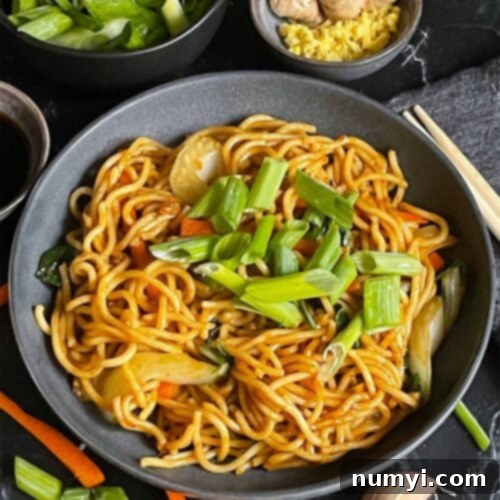
Easy Vegetable Lo Mein Recipe
Print
Pin
Rate
Ingredients
The Flavorful Lo Mein Sauce
- 1/4 cup Vegetable Stock
- 1 tsp Corn Starch
- 3 tbsp Oyster Sauce
- 1 tbsp Dark Soy Sauce
- 2 tsp Sesame Oil
For the Lo Mein Dish
- 1 tbsp Vegetable Oil
- 1 tbsp Fresh Ginger finely diced
- 1 tsp Fresh Garlic finely diced
- 2 cups Bok Choy chopped, or 1 baby bok choy
- 1/2 Large Carrot thinly sliced into sticks
- 14 oz Cooked Stir Fry Noodles
- 3 Green Onions for garnish, sliced on a bias
Instructions
-
Prepare your vegetables: finely dice ginger and garlic. Chop bok choy into bite-sized pieces and slice carrots into thin sticks. Slice green onions on a bias for garnish.
-
In a small bowl, whisk together vegetable stock and cornstarch until completely smooth and lump-free.1/4 cup Vegetable Stock, 1 tsp Corn Starch
-
Add dark soy sauce, oyster sauce, and sesame oil to the cornstarch mixture. Whisk thoroughly until well combined to form the Lo Mein sauce. Set aside.3 tbsp Oyster Sauce, 1 tbsp Dark Soy Sauce, 2 tsp Sesame Oil
-
If using dry noodles, cook according to package directions until al dente. Rinse under cold water to stop cooking and prevent sticking, then drain well. If using fresh noodles, have them ready.
-
Heat vegetable oil in a large pan or wok over medium-high heat until shimmering. Add diced ginger and garlic, stir-frying for about 1 minute until fragrant and lightly golden.1 tbsp Vegetable Oil, 1 tbsp Ginger, 1 tsp Garlic
-
Add sliced carrots and chopped bok choy to the pan. Stir-fry for 2-3 minutes until vegetables are tender-crisp, maintaining their vibrant color.2 cups Bok Choy, 1/2 Carrot
-
Add the cooked noodles to the pan with the vegetables. Toss everything together vigorously to combine. Continue to cook for another two minutes, allowing some noodles to crisp slightly.14 oz Cooked Stir Fry Noodles
-
Pour the prepared sauce evenly over the noodles and vegetable mixture in the pan. Stir well and continuously toss to ensure all ingredients are evenly coated. Cook for 1-2 minutes until the sauce thickens to a glossy consistency and clings beautifully to the noodles.
-
Remove the pan from the heat immediately. Serve your homemade Vegetable Lo Mein hot, garnished generously with the sliced green onions. Enjoy!3 Green Onions
Notes
To ensure your leftovers stay fresh and delicious, place any cooled Lo Mein in an airtight container immediately after dinner. Refrigerate it for up to 3-4 days. When you’re ready to enjoy it again, simply reheat in a microwave or gently on the stovetop over medium heat. Adding a small splash of water or a little extra soy sauce (or vegetable stock) during reheating can help rehydrate the noodles and refresh the flavors, bringing it back to nearly its original glory.
